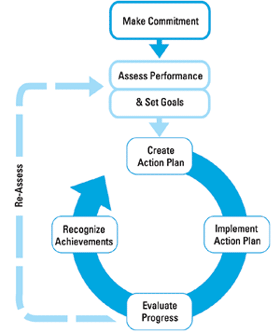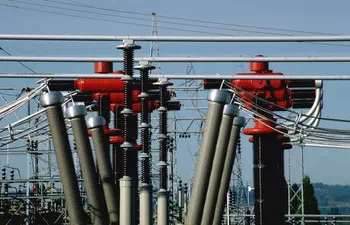Facilities Management — Energy Efficiency
U.S. hospitals use an average of 27.5 kilowatt-hours of electricity and 110 cubic feet of natural gas per square foot annually. Based on average energy prices (2005), this translates to a total energy cost of $3.71 per square foot. A typical breakdown of energy use is shown in the figure below. Healthcare facilities that have implemented extensive energy efficiency programs have been able to cut energy use by 20%. For a 150,000 ft2 hospital, this can mean annual savings of $111,300.
In addition to dollar savings, efficient energy use is good for the environment. Most of the energy generated by power plants in the United States comes from burning fossil fuels. When we use less energy, fewer fossil fuels are consumed which means less pollution. To learn more about the environmental impacts of energy use, visit EPA's Clean Energy and Climate Change web pages.
Increasing our energy efficiency also reduces our dependency on foreign sources of energy, thereby improving the reliability and security of our energy system.

This section of the web site outlines ways of reducing energy use. Much of the information presented follows the system promoted by ENERGY STAR, a joint program of the U.S. Environmental Protection Agency and the U.S. Department of Energy. The goal of ENERGY STAR is to help us all save money and protect the environment through energy efficient products and practices.
Over 850 hospitals and other healthcare facilities have participated in ENERGY STAR programs (see list). EPA offers a proven strategy for superior energy management with tools and resources to help each step of the way. Based on the successful practices of ENERGY STAR partners, these guidelines for energy management can assist your organization in improving its energy and financial performance while distinguishing your organization as an environmental leader.
The ENERGY STAR program involves a logical sequence of tasks that involves assessing your current practices/energy use, developing a plan, implementation, and evaluation. There is also an emphasis on continual improvement through reassessment and further change. A diagram of the process is shown in the figure below.
ENERGY STAR Management Steps

ENERGY STAR also promotes program recognition:
Providing recognition to those who helped the organization achieve these results motivates staff and employees and brings positive exposure to the energy management program.
Receiving recognition from outside sources validates the importance of the energy management program to both internal and external stakeholders, and provides positive exposure for the organization as a whole.
ENERGY STAR provides several means of external recognition:
ENERGY STAR partnership -- to partner with ENERGY STAR, your CEO, CFO, or top administrator must sign the partnership letter, committing your organization to continuous improvement of your energy efficiency. As part of this commitment, you agree to:
Measure, track, and benchmark your energy performance;
Develop and implement a plan to improve your energy performance, adopting the ENERGY STAR strategy; and
Educate your staff and the public about your partnership and achievements with ENERGY STAR
Healthcare facilities that meet widely recognized standards of performance, such as those established by ENERGY STAR, that reflect superior performance can achieve the ENERGY STAR building label
Healthcare facilities that surpass a variety of predetermined criteria, often both qualitative and quantitative, that identify superior energy management programs may be eligible for an ENERGY STAR Award
The ENERGY STAR Buildings Five-Stage Strategy
The Program is built around a five-stage strategy for upgrading a building's operating efficiency. By approaching these stages in a priority order, reducing loads before purchasing new HVAC equipment, systems interactions can be turned into first cost reductions and greater operating cost savings. The ENERGY STAR Buildings five stages are:
Stage 1: Green Lights. Green Lights focuses on lighting systems. Energy savings accrue from using proven, reliable lighting technologies to achieve optimal light levels, gain control over the hours of operation, and maintain or improve lighting quality. Participants across the country average a 48% reduction in lighting related energy use.
Stage 2: Building Tune-up A building tune-up saves energy by eliminating waste and returning the building equipment to the intended calibrations and settings.
Stage 3: Other Load Reductions. The building envelope can yield tremendous opportunities for additional load reductions on the mechanical system. Installing window film, weather stripping to seal windows and doors, roof and wall insulation, and energy-efficient office equipment can further contribute to significant reductions in heating and cooling loads.
Stage 4: Air Handling Systems. The average building ventilation system is 38% larger than necessary. Considering that the ventilation systems can account for up to 30% of the energy use in a building, there is a huge potential for savings.
Stage 5: Other Heating and Cooling Plant Improvements. This stage is the culmination for the previous load reductions in stages 1-4. Heating and cooling for most buildings is accomplished by chillers, boilers, or packaged direct-expansion systems. Most of the load reductions obtained through the previous four stages benefit the cooling side. However, efficiency modifications to the boilers and other gains from sealing air-infiltration and improving insulation can negate any heat losses in the heating season.
Beyond traditional funding approaches to energy efficiency, there are some creative opportunities for healthcare administrators to consider. The most common are lease-purchase performance contracting, shared-savings, and revolving funds. In addition, ENERGY STAR Building Allies, companies that plan and install energy efficiency upgrades, frequently provide project funding options. Newer approaches are also being offered by power marketers and non-traditional utilities. Here are some avenues to consider:
Performance Contracting. This type of approach can be performed on a lease purchase or shared savings basis. The savings are guaranteed by the energy service company (ESCo).
Shared Savings. Shared savings is a unique and complex financing method whose primary benefit is reducing the risk of the energy efficiency upgrades. This financing option is typically used to procure building-wide upgrades of HVAC, hot water, and light systems and yields. The key components are: no down payment, third-party ownership of capital and improvements during the term of the agreement, a positive cash flow, and no performance-based payments.
Revolving Funds. This is another new approach in which loans are set-up to fund upgrades and then the loans are repaid from the savings generated in the utility budget.
Power Marketers and Nontraditional Utilities. Strategies to link energy supply-side needs with demand-side alternatives are being employed. These strategies are centered around cost minimization, cost stabilization and budget predictability, procurement simplification, and risk management.
State Financing. For example, the California Energy Commission's Energy Efficiency Financing Program provides financing for schools, hospitals and local governments through low-interest loans for feasibility studies and the installation of energy-saving measures.
NEW CONSTRUCTION
Leadership in Energy and Environmental Design (LEED) Green Building Rating System®. LEED provides a national performance rating system, developed by members of the United States Green Building Council. This point system encourages use of many aspects of environmental design. The energy-efficiency section contains the greatest number of potential points.
Green Guide for Health Care. This is a quantifiable sustainable design tool kit for integrating enhanced environmental and health principles and practices into the planning, design, construction, operations and maintenance of health care facilities. The guide provides a voluntary, self-certifying metric toolkit of best practices that designers, owners, and operators can use to guide and evaluate their progress towards high performance healing environments.
ENERGY STAR Target Finder. This tool helps manage energy during the design of a new building by setting an energy performance target and comparing the estimated energy consumption to the established target.
EXISTING CONSTRUCTION
Building Operator Certification (BOC). BOC is a certification program for facilities operations and maintenance staff. Training focuses on maintaining and operating of building systems at peak efficiency.
LEED – EB. Developed under the LEED umbrella (see below left), this ranking system addresses building issues, retrofits, and upgrades where "the majority of interior or exterior surfaces remain unchanged."
Federal Energy Management Program (FEMP). While this program is focused primarily on saving energy within the federal government, it offers software tools, publications, videos, and other resources for a wide range of energy managers.




